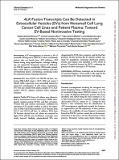Por favor, use este identificador para citar o enlazar a este item:
http://hdl.handle.net/10261/346457COMPARTIR / EXPORTAR:
 SHARE SHARE
 CORE
BASE CORE
BASE
|
|
| Visualizar otros formatos: MARC | Dublin Core | RDF | ORE | MODS | METS | DIDL | DATACITE | |

| Título: | ALK-Fusion Transcripts Can Be Detected in Extracellular Vesicles (EVs) from Nonsmall Cell Lung Cancer Cell Lines and Patient Plasma: Toward EV-Based Noninvasive Testing |
Autor: | Sánchez-Herrero, Estela; Campos-Silva, Carmen CSIC ORCID; Cáceres-Martell, Yaiza; Robado de Lope, Lucía; Sanz-Moreno, Sandra; Serna-Blasco, Roberto; Rodríguez-Festa, Alejandro; Ares Trotta, Dunixe; Martín-Acosta, Paloma; Patiño, Cristina; Coronado, María José CSIC ORCID; Beneítez-Martínez, Alexandra; Jara, Ricardo; Lago-Baameiro, Nerea; Camino, Tamara; Cruz-Bermúdez, Alberto CSIC ORCID; Pardo, María; González-Rumayor, Víctor; Valés-Gómez, Mar CSIC ORCID ; Provencio, Mariano; Romero, Atocha | Palabras clave: | ALK-TKI EML4-ALK Extracellular vesicles Liquid biopsy NSCLC |
Fecha de publicación: | may-2022 | Editor: | Oxford University Press | Citación: | Clinical Chemistry 68(5): 668–679 (2022) | Resumen: | [Background]: ALK rearrangements are present in 5% of nonsmall cell lung cancer (NSCLC) tumors and identify patients who can benefit from ALK inhibitors. ALK fusions testing using liquid biopsies, although challenging, can expand the therapeutic options for ALK-positive NSCLC patients considerably. RNA inside extracellular vesicles (EVs) is protected from RNases and other environmental factors, constituting a promising source for noninvasive fusion transcript detection. [Methods]: EVs from H3122 and H2228 cell lines, harboring EML4-ALK variant 1 (E13; A20) and variant 3 (E6a/b; A20), respectively, were successfully isolated by sequential centrifugation of cell culture supernatants. EVs were also isolated from plasma samples of 16 ALK-positive NSCLC patients collected before treatment initiation. [Results]: Purified EVs from cell cultures were characterized by transmission electron microscopy (TEM), nanoparticle tracking analysis (NTA), and flow cytometry. Western blot and confocal microscopy confirmed the expression of EV-specific markers as well as the expression of EML4-ALK-fusion proteins in EV fractions from H3122 and H2228 cell lines. In addition, RNA from EV fractions derived from cell culture was analyzed by digital PCR (dPCR) and ALK-fusion transcripts were clearly detected. Similarly, plasma-derived EVs were characterized by NTA, flow cytometry, and the ExoView platform, the last showing that EV-specific markers captured EV populations containing ALK-fusion protein. Finally, ALK fusions were identified in 50% (8/16) of plasma EV-enriched fractions by dPCR, confirming the presence of fusion transcripts in EV fractions. [Conclusions]: ALK-fusion transcripts can be detected in EV-enriched fractions. These results set the stage for the development of EV-based noninvasive ALK testing. |
Versión del editor: | https://doi.org/10.1093/clinchem/hvac021 | URI: | http://hdl.handle.net/10261/346457 | DOI: | 10.1093/clinchem/hvac021 | ISSN: | 0009-9147 | E-ISSN: | 1530-8561 |
| Aparece en las colecciones: | (CNB) Artículos |
Ficheros en este ítem:
| Fichero | Descripción | Tamaño | Formato | |
|---|---|---|---|---|
| ALK-Fusion_Sánchez_Herrero_Art_2022.pdf | 1,14 MB | Adobe PDF |  Visualizar/Abrir |
CORE Recommender
SCOPUSTM
Citations
5
checked on 18-mar-2024
WEB OF SCIENCETM
Citations
3
checked on 22-feb-2024
Page view(s)
16
checked on 28-abr-2024
Download(s)
10
checked on 28-abr-2024
Google ScholarTM
Check
Altmetric
Altmetric
Este item está licenciado bajo una Licencia Creative Commons

